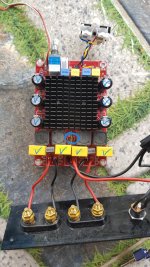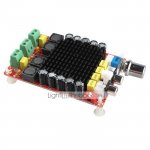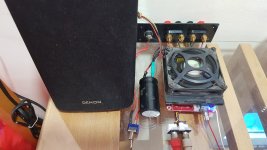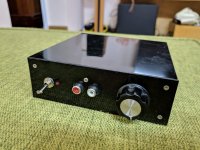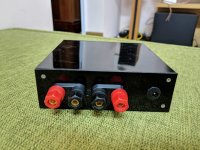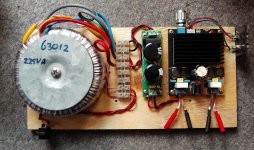PBTL is nothing else but putting more mosfets of the final amplifier stage in parallel the chip amp way. Like many discrete A/B amps whose only difference lie in the number of power transistors and the rail voltage.
Here the higher current capability is used to drive a lower impedance load giving more power without raising the rail voltage.
As far as I remember this has also been used with A/B chipamps, which sounded much better because of groups working in parallel. The more amps are connected, the lower the output impedance of the amp. I don´t remember who build this amps, but I think one was from Germany.
As allways with D-amps, the resulting output filter is a field of discussion and in real live mostly some compromise.
Here the higher current capability is used to drive a lower impedance load giving more power without raising the rail voltage.
As far as I remember this has also been used with A/B chipamps, which sounded much better because of groups working in parallel. The more amps are connected, the lower the output impedance of the amp. I don´t remember who build this amps, but I think one was from Germany.
As allways with D-amps, the resulting output filter is a field of discussion and in real live mostly some compromise.
PBTL is nothing else but putting more mosfets of the final amplifier stage in parallel the chip amp way. Like many discrete A/B amps whose only difference lie in the number of power transistors and the rail voltage.
Here the higher current capability is used to drive a lower impedance load giving more power without raising the rail voltage.
As far as I remember this has also been used with A/B chipamps, which sounded much better because of groups working in parallel. The more amps are connected, the lower the output impedance of the amp. I don´t remember who build this amps, but I think one was from Germany.
As allways with D-amps, the resulting output filter is a field of discussion and in real live mostly some compromise.
TDA7293 is foreseen for more TDA7293 output stages working in parallel with a TDA7293 master chip. I have seen many high power discrete designs with a plurality of parallel-coupled power transistors.
My TDA7498 (code XH-M510 as attached pictures) board keeps entering protection mode after about 20 to 40 minutes running, and I don't know why 😕
I did some mods:
- Short the power anti-reverse diode
- Change output filter capacitors to a different type but the same value (220nF)
- Change decoupling capacitors from 220uF/63V to 470uF/63V
I don't think it's a thermal issue, because with the heatsink removed the board keeps running as long as with heatsink installed 😕
Can somebody help me find the problem please? 🙂
I did some mods:
- Short the power anti-reverse diode
- Change output filter capacitors to a different type but the same value (220nF)
- Change decoupling capacitors from 220uF/63V to 470uF/63V
I don't think it's a thermal issue, because with the heatsink removed the board keeps running as long as with heatsink installed 😕
Can somebody help me find the problem please? 🙂
Attachments
Hi
According to the datasheet the TDA7498 has 2 protections:
- short cut porotection
- thermal protection
which one do you uncover??
maybe a mute topic-? so the mute circuit force the chip to switch off?
you can re check the power supply- maybe this gets hot and switch off
chris
According to the datasheet the TDA7498 has 2 protections:
- short cut porotection
- thermal protection
which one do you uncover??
maybe a mute topic-? so the mute circuit force the chip to switch off?
you can re check the power supply- maybe this gets hot and switch off
chris
Hi
According to the datasheet the TDA7498 has 2 protections:
- short cut porotection
- thermal protection
which one do you uncover??
maybe a mute topic-? so the mute circuit force the chip to switch off?
you can re check the power supply- maybe this gets hot and switch off
chris
I removed the heatsink (the square - black one) just for testing purpose, to check if the problem is overheating or not 😛
I think if the problem is overheating then without the heatsink TDA7498 will fall into protection mode sooner, but in the reality my TDA7498 board continues to play in the period as long as when it has the heatsink. So I don't think it has overheating problem.
I will recheck and report again. Thank you, chermann! 😉
Hi zerofill
for me its logical that you push the amp very hard...if you get /want to get 100W each and the efficiency is about 90% you loose about 10W per channel =20W at the amp...and that is a lot !!!
mybe some other protection kick in.....
protection:
it s my mistake there are more protection:
maybe you can check all of them
Overvoltage protection (OVP)
If the supply voltage exceeds the value for VOVP given in Table 6: "Electrical specifications
", the overvoltage protection is activated which forces the outputs to the high-impedance
state. When the supply voltage falls back to within the operating range, the device restarts.
Undervoltage protection (UVP)
If the supply voltage drops below the value for VUVP given in Table 6: "Electrical specifications ", the undervoltage protection is activated which forces the outputs to the high-impedance state. When the supply voltage falls back to within the operating range, the device restarts.
--> weak power supply. could be the reason...e.g. laptop brick
Overcurrent protection (OCP)
If the output current exceeds the value for IOCP given in Table 6: "Electrical specifications ",the overcurrent protection is activated which forces the outputs to the high-impedance state. Periodically, the device attempts to restart. If the overcurrent condition is still present, then the OCP remains active. The restart time, TOC, is determined by the RC components connected to pin STBY.
Thermal protection (OTP)
If the junction temperature, Tj, reaches 145 °C (nominally), the device goes to mute mode and the positive and negative PWM outputs are forced to 50% duty cycle. If the junction temperature reaches the value for Tj given in Table 6: "Electrical specifications ", the device shuts down and the output is forced to the high-impedance state. When the device cools sufficiently the device restarts.
chris
for me its logical that you push the amp very hard...if you get /want to get 100W each and the efficiency is about 90% you loose about 10W per channel =20W at the amp...and that is a lot !!!
mybe some other protection kick in.....
protection:
it s my mistake there are more protection:
maybe you can check all of them
Overvoltage protection (OVP)
If the supply voltage exceeds the value for VOVP given in Table 6: "Electrical specifications
", the overvoltage protection is activated which forces the outputs to the high-impedance
state. When the supply voltage falls back to within the operating range, the device restarts.
Undervoltage protection (UVP)
If the supply voltage drops below the value for VUVP given in Table 6: "Electrical specifications ", the undervoltage protection is activated which forces the outputs to the high-impedance state. When the supply voltage falls back to within the operating range, the device restarts.
--> weak power supply. could be the reason...e.g. laptop brick
Overcurrent protection (OCP)
If the output current exceeds the value for IOCP given in Table 6: "Electrical specifications ",the overcurrent protection is activated which forces the outputs to the high-impedance state. Periodically, the device attempts to restart. If the overcurrent condition is still present, then the OCP remains active. The restart time, TOC, is determined by the RC components connected to pin STBY.
Thermal protection (OTP)
If the junction temperature, Tj, reaches 145 °C (nominally), the device goes to mute mode and the positive and negative PWM outputs are forced to 50% duty cycle. If the junction temperature reaches the value for Tj given in Table 6: "Electrical specifications ", the device shuts down and the output is forced to the high-impedance state. When the device cools sufficiently the device restarts.
chris
Last edited:
@chermann: Thank you! I've read the datasheet many times, and I'm still trying to figure it out. 🙂
I've tested my TDA7498 board with a 19VDC/3.45A laptop brick adapter and a 24VDC/5A transformer, so I don't think it's about the power issue.
I saw that all protections seem to cause the same symptom "outputs to the high-impedance state", except with Over Thermal "the device goes to mute mode and the positive and negative PWM outputs are forced to 50% duty cycle". When my board gets protection kick in it suddenly muted and after some minutes it goes back active. I will try to replace another heatsink to confirm if it has thermal issue or not.
I've tested my TDA7498 board with a 19VDC/3.45A laptop brick adapter and a 24VDC/5A transformer, so I don't think it's about the power issue.
I saw that all protections seem to cause the same symptom "outputs to the high-impedance state", except with Over Thermal "the device goes to mute mode and the positive and negative PWM outputs are forced to 50% duty cycle". When my board gets protection kick in it suddenly muted and after some minutes it goes back active. I will try to replace another heatsink to confirm if it has thermal issue or not.
@chermann: Thank you! I've read the datasheet many times, and I'm still trying to figure it out. 🙂
I've tested my TDA7498 board with a 19VDC/3.45A laptop brick adapter and a 24VDC/5A transformer, so I don't think it's about the power issue.
I saw that all protections seem to cause the same symptom "outputs to the high-impedance state", except with Over Thermal "the device goes to mute mode and the positive and negative PWM outputs are forced to 50% duty cycle". When my board gets protection kick in it suddenly muted and after some minutes it goes back active. I will try to replace another heatsink to confirm if it has thermal issue or not.
hi Zerofill
I do not follow up what you want to do with this amp...but i guess you want to push it hard...
24V * 5A = 120VA transformer...so for a sub amp not much 😉
chris
...... I will try to replace another heatsink to confirm if it has thermal issue or not.
Very good advises you got from Chris.
When you want to check thermal issues like a sufficiently big and efficient heatsink, changing it for a start into a bigger heatsink is the difficult way. I use an ordinary table fan for such testing. Put near to the existing heatsink it is like using a MUCH BIGGER heatsink. Don't care for a start about the hiss from the fan. If the amplifier with the initial heatsink and a fan works, start thinking about how you realistically get a better cooling system in place. If your chip still shuts down, you were looking in the wrong direction and need not spend time on a more difficult replacement of the heatsink.
@FauxFrench and Chermann: Thank you again! The "fan solution" worked! 🙂 With a CPU cooler fan on the top of the heatsink, my TDA7498 board operates at max volume for a 2 hours period continuously without halting. Again, it's a "matter of price" as you said, the Chinese cheap boards come with cheap and insufficient quality components so they didn't work as they should.
I want to build a simple, compact and cheap stereo system with this TDA7498 and 2 Denon SC-F1312 (6 Ohm-60W) speakers, so I made a chassis for it (as pictures). But this chassis seems too tight for this board, at least it's doesn't have enough space in case of upgrading the heatsink. I think TDA7498 is more thermally sensitive than TPA3116D2 I've used before because I'd put TPA3116D2 to an even smaller chassis 😛
I want to build a simple, compact and cheap stereo system with this TDA7498 and 2 Denon SC-F1312 (6 Ohm-60W) speakers, so I made a chassis for it (as pictures). But this chassis seems too tight for this board, at least it's doesn't have enough space in case of upgrading the heatsink. I think TDA7498 is more thermally sensitive than TPA3116D2 I've used before because I'd put TPA3116D2 to an even smaller chassis 😛
Attachments
@FauxFrench and Chermann: Thank you again! The "fan solution" worked! 🙂 With a CPU cooler fan on the top of the heatsink, my TDA7498 board operates at max volume for a 2 hours period continuously without halting. Again, it's a "matter of price" as you said, the Chinese cheap boards come with cheap and insufficient quality components so they didn't work as they should.
I want to build a simple, compact and cheap stereo system with this TDA7498 and 2 Denon SC-F1312 (6 Ohm-60W) speakers, so I made a chassis for it (as pictures). But this chassis seems too tight for this board, at least it's doesn't have enough space in case of upgrading the heatsink. I think TDA7498 is more thermally sensitive than TPA3116D2 I've used before because I'd put TPA3116D2 to an even smaller chassis 😛
Good morning Zerofill
well done !🙂
my 2 cents:
just a small hint for better performance....drill holes in the buttom and top plate where the amp is ...so the air can better flow.
read the comlete thread here...some expert know very well what to do😉
i learned a lot...
https://www.diyaudio.com/forums/class-d/265387-ebay-cheap-tda7498-boards-43.html#post5292329
chris
Good morning Zerofill
well done !🙂
my 2 cents:
just a small hint for better performance....drill holes in the buttom and top plate where the amp is ...so the air can better flow.
read the comlete thread here...some expert know very well what to do😉
i learned a lot...
https://www.diyaudio.com/forums/class-d/265387-ebay-cheap-tda7498-boards-43.html#post5292329
chris
Thanks! These pictures are taken when I just finish the chassis, now it has some drill hole on the top and bottom already 🙂
I will follow your link
Hiss
Good morning!
I had the TDA7498 (the black one with the speaker outputs inverted at one channel) on the shelf for some time and only recently hooked it up to a 35V power supply (toroid transformer with rectifier board).
Prior to that I changed the on board capacitor for a 50V version.
This amp is loud...
On a 4Ohm load the volume knob doesn't get beyond the nine o'clock position.
There is a distinctive hiss in the sound, something that is very tireing over time.
I've read this entire thread and can't remember where I read about this issue and it's remedy.
Can somebody please point me in the right direction, which of the 70 pages I should look into?
Regards, Jan.
Good morning!
I had the TDA7498 (the black one with the speaker outputs inverted at one channel) on the shelf for some time and only recently hooked it up to a 35V power supply (toroid transformer with rectifier board).
Prior to that I changed the on board capacitor for a 50V version.
This amp is loud...
On a 4Ohm load the volume knob doesn't get beyond the nine o'clock position.
There is a distinctive hiss in the sound, something that is very tireing over time.
I've read this entire thread and can't remember where I read about this issue and it's remedy.
Can somebody please point me in the right direction, which of the 70 pages I should look into?
Regards, Jan.
It is loud at "nine o'clock" because you have too much gain in the signal path. That can easily be changed. First, I need to know if the TDA7498 amplifier has hiss when you disconnect it from the input source and short-circuit the input terminals? If so, the gain in the TDA7498 amplifier itself should be reduced.
Good morning FauxFrench,
That was quick....
I Initially tested the amp on my PC; normally I have the output of the sound card at max and reduce the volume with the amp that normally powers my speakers (a 2 x 50W D-class), depending on the source, this amp plays at the 10-11 o'clock position.
With the TDA7498 hooked up, even with the volume on the soundcard reduced, the harshness in the high end remains.
In my living, hooked up to the 4Ohm MTM speakers and the CD player (which doesn't have a volume control) I couln't get over the eight o'clock position without serious complaints of my wife (who sat like paralised, when I turned up the volume slightly...)
Here, the sound was very 'bright' to the point it started to hurt when I turned up the volume.
Only by reducing the volume and adding the subwoofer, it started to sound better balanced...
I listened to various pieces of music, but didn't complete a single song, as the brightness took it's toll every time.
I'll short circuit the inputs and let you know.
Regards, Jan.
That was quick....
I Initially tested the amp on my PC; normally I have the output of the sound card at max and reduce the volume with the amp that normally powers my speakers (a 2 x 50W D-class), depending on the source, this amp plays at the 10-11 o'clock position.
With the TDA7498 hooked up, even with the volume on the soundcard reduced, the harshness in the high end remains.
In my living, hooked up to the 4Ohm MTM speakers and the CD player (which doesn't have a volume control) I couln't get over the eight o'clock position without serious complaints of my wife (who sat like paralised, when I turned up the volume slightly...)
Here, the sound was very 'bright' to the point it started to hurt when I turned up the volume.
Only by reducing the volume and adding the subwoofer, it started to sound better balanced...
I listened to various pieces of music, but didn't complete a single song, as the brightness took it's toll every time.
I'll short circuit the inputs and let you know.
Regards, Jan.
With a croc clamp, connecting the center to the ground on both inputs, I can turn up the volume all the way and don't hear any hiss from the speakers.
In fact, there's less noise than when I turn up the elderly Technics amp, which normally powers these speakers (but that is with everything connected offcourse).
Regards, Jan.
In fact, there's less noise than when I turn up the elderly Technics amp, which normally powers these speakers (but that is with everything connected offcourse).
Regards, Jan.
Not to polute my own topic; I also have one of these:
Replacement TDA7498 2*100W Digital Power Amplifier Board Class D Dual Audio Ster | eBay
Powering up this board is next on my list, but I'll use a switching powersupply (24V 5A), due to the 35V capacitors on it...
Regards, Jan.
Replacement TDA7498 2*100W Digital Power Amplifier Board Class D Dual Audio Ster | eBay
Powering up this board is next on my list, but I'll use a switching powersupply (24V 5A), due to the 35V capacitors on it...
Regards, Jan.
First amplifier: You can set the amplifier gain to 25.6dB, 31.6dB, 35.1dB or 37.6dB. 37.6db is what is shown in the datasheet example. With pins 30 and 31 at 3.3V you have the maximum of 37.6dB. If you instead connect these two pins to GND you have the minimum of 25.6dB. That will help both on your "nine o'clock" problem and your hiss that most likely origins from the source. The problem is you will have to cut and connect very tiny SMD tracks. Do you know how to do that?
Just to be sure, your DC supply voltage is 35Vdc, not using a 35Vac transformer?
The other way around is to make a simple amplitude reduction circuit with around 20dB damping. Two 22K resistors and two 2.2K resistors. Connect them in series, the other end of the 22K connected to your signal source (CD player), the other end of the 2.2K connected to GND and the signal to the input of your amplifier taken from the midpoint between the 22K and 2.2K.
We look at the other amplifier afterwards.
Just to be sure, your DC supply voltage is 35Vdc, not using a 35Vac transformer?
The other way around is to make a simple amplitude reduction circuit with around 20dB damping. Two 22K resistors and two 2.2K resistors. Connect them in series, the other end of the 22K connected to your signal source (CD player), the other end of the 2.2K connected to GND and the signal to the input of your amplifier taken from the midpoint between the 22K and 2.2K.
We look at the other amplifier afterwards.
Last edited:
To avoid confusion (I know I shouldn't have mentioned the 'other' amp board), I added a picture of my current test set-up.
The transformer is a 2 x 12V AC, secundairy windings connected in series for 24VAC and rectified to get 32V DC. (It's actually closer to 35V without load.)
DC to the amp board is soldered onto the back, directly onto the connectors of the barrel connector. With this Voltage I don't trust the tiny contact surface of the plug I'm supposed to use for it.
Same goes for the RCA inputs, as I don't have the proper connectors at hand, short of robbing a servo of it's leads.
Regarding the gain settings; when I search for TDA7698, I get several datasheets with different additions, the one I'm looking at is the TDA7498L (80 watt + 80 watt dual BTL class-D audio amplifier) on the ST site.
I'm not used to working with SMD equipment, (way too small at 66 years, magnifying glass only helps so much) but I'll manage if I have to.
This requires taking the heatsink off to gain access I imagine, any specifics I should keep in mind when doing that?
Regards, Jan.
The transformer is a 2 x 12V AC, secundairy windings connected in series for 24VAC and rectified to get 32V DC. (It's actually closer to 35V without load.)
DC to the amp board is soldered onto the back, directly onto the connectors of the barrel connector. With this Voltage I don't trust the tiny contact surface of the plug I'm supposed to use for it.
Same goes for the RCA inputs, as I don't have the proper connectors at hand, short of robbing a servo of it's leads.
Regarding the gain settings; when I search for TDA7698, I get several datasheets with different additions, the one I'm looking at is the TDA7498L (80 watt + 80 watt dual BTL class-D audio amplifier) on the ST site.
I'm not used to working with SMD equipment, (way too small at 66 years, magnifying glass only helps so much) but I'll manage if I have to.
This requires taking the heatsink off to gain access I imagine, any specifics I should keep in mind when doing that?
Regards, Jan.
Attachments
- Status
- Not open for further replies.
- Home
- Amplifiers
- Class D
- Ebay cheap TDA7498 boards
